Discover 50 hidden attractions, cool sights, and unusual things to do in Bulgaria. Don't miss out on these must-see attractions: Alexander Nevsky Cathedral (Sofia), Boyana Church (Sofia) or Vitosha Boulevard (Sofia).
Below, you can find the list of the most amazing places you should visit in Bulgaria.
Table of Contents
Alexander Nevsky Cathedral, Sofia
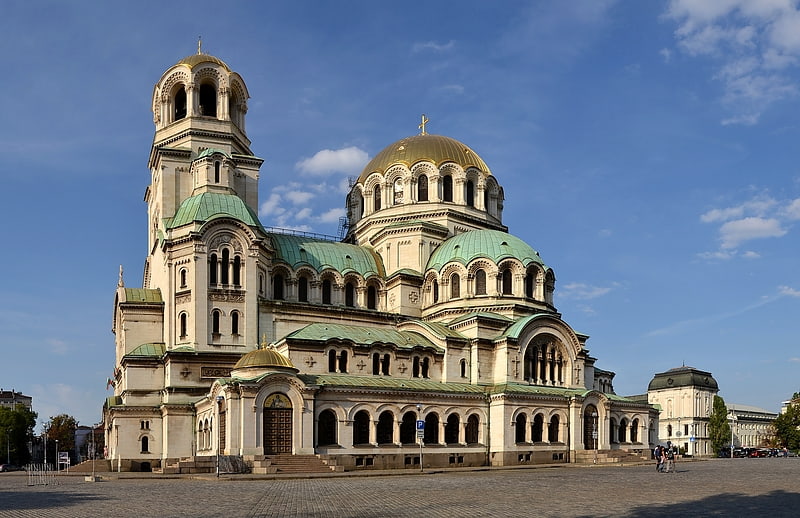
Also known as: Свети Александър Невски
Landmark Orthodox church with a museum. St. Alexander Nevsky Cathedral is a Bulgarian Orthodox cathedral in Sofia, the capital of Bulgaria. Built in Neo-Byzantine style, it serves as the cathedral church of the Patriarch of Bulgaria and it is believed to be one of the 50 largest Christian church buildings by volume in the world. It is one of Sofia's symbols and primary tourist attractions. St. Alexander Nevsky Cathedral in Sofia occupies an area of 3,170 square metres and can hold 5,000 people inside. It is believed to be among the 10 largest Eastern Orthodox church buildings. It is the largest cathedral in the Balkans. It is believed that until year 2000 it was the largest finished Orthodox cathedral.[1]
Address: pl. "Sveti Aleksandar Nevski", 1000 Sofia
Boyana Church, Sofia
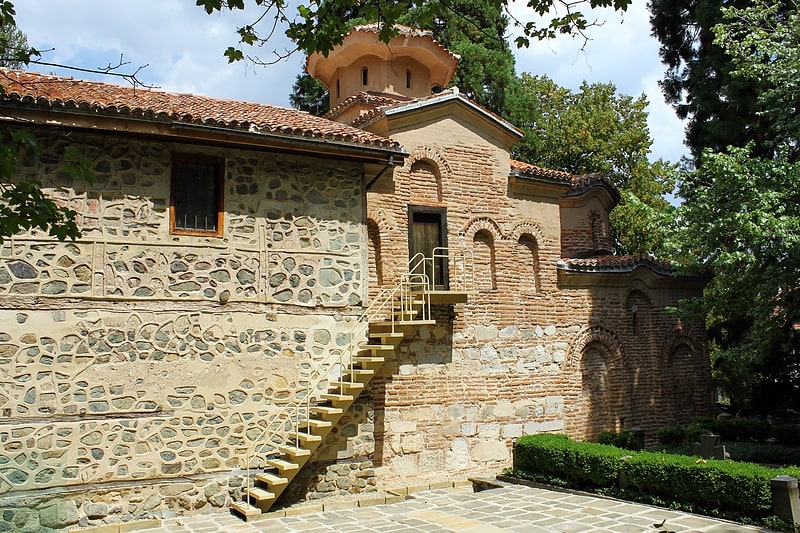
Also known as: Боянска църква
Fresco-filled church from 10th century. The Boyana Church is a medieval Bulgarian Orthodox church situated on the outskirts of Sofia, the capital of Bulgaria, in the Boyana quarter. In 1979, the building was added to the UNESCO World Heritage List.
The east wing of the two-storey church was originally constructed in the late 10th or early 11th century, then the central wing was added in the 13th century under the Second Bulgarian Empire, the whole building being finished with a further expansion to the west in the middle of the 19th century. A total of 89 scenes with 240 human images are depicted on the walls of the church.[2]
Address: ул. Боянско езеро 3, 1616 Sofia
Vitosha Boulevard, Sofia
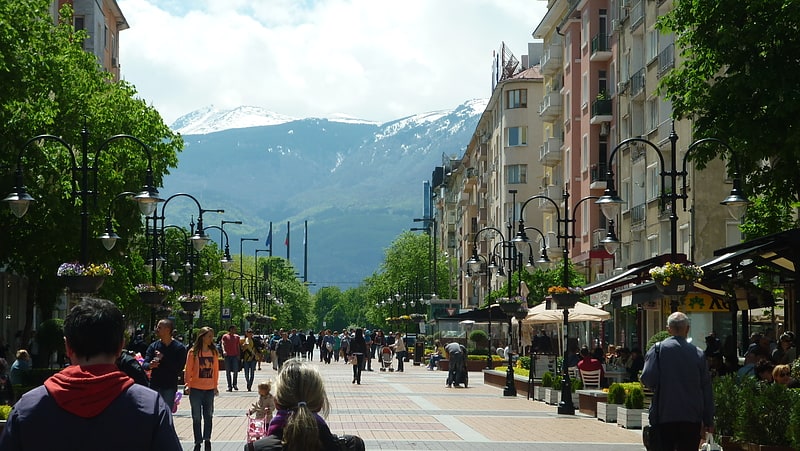
Also known as: Витоша
Main street in Sofia, Bulgaria. Vitosha Boulevard is the main commercial street in the centre of Sofia, the capital of Bulgaria, which is abundant in posh stores, restaurants and bars. It extends from the St Nedelya Square to the Southern Park. Many high-end fashion labels have outlets on Vitosha boulevard and the neighbouring streets: Versace, Escada, Bulgari, D&G, La Perla, Lacoste, Van Laak, Ermenegildo Zegna, Tru Trussardi, Moreschi, Marella, Max Mara, Gianfranco Ferré, Emporio Armani, Tommy Hilfiger, Boss, Baldinini. Among the notable buildings, located on the boulevard are: The National Palace of Culture, The Palace of the Courts, the house where the famous Bulgarian poet Peyo Yavorov lived and died. The corner of Vitosha and Patriarch Evtimiy boulevards, so called the Pharmacy, is a popular place for meetings.
The boulevard is named after Vitosha, the mountain just next to Sofia. It was an unadjusted street during the Ottoman rule of Bulgaria and acquired the name Vitoshka ulitsa ("Vitosha Street") after the Liberation, in 1883. The street was initially built up with low one-storey houses, but turned into an imposing trade street in the Interwar period as massive public buildings were constructed, changing Vitoshka's appearance completely.
According to a 2007 Cushman & Wakefield, Inc. study, Vitosha Boulevard is the world's 22nd most expensive trade street.
In May 2007, a renovation of the boulevard was announced, which aimed to restore the style of 1930s Sofia. Historical benches and street lights were added, as well as Art Nouveau round kiosks, more green areas, fountains, open-air bars, and a clock tower at the St Nedelya Church displaying the time in various world capitals.
In March 2013, reconstruction works on the boulevard started.
In summer 2015, there was another renovation of the boulevard completing the entirely pedestrian zone of the boulevard between Patriarch Evtimiy Blvd. and Alabin Str.[3]
Varna Archaeological Museum, Varna
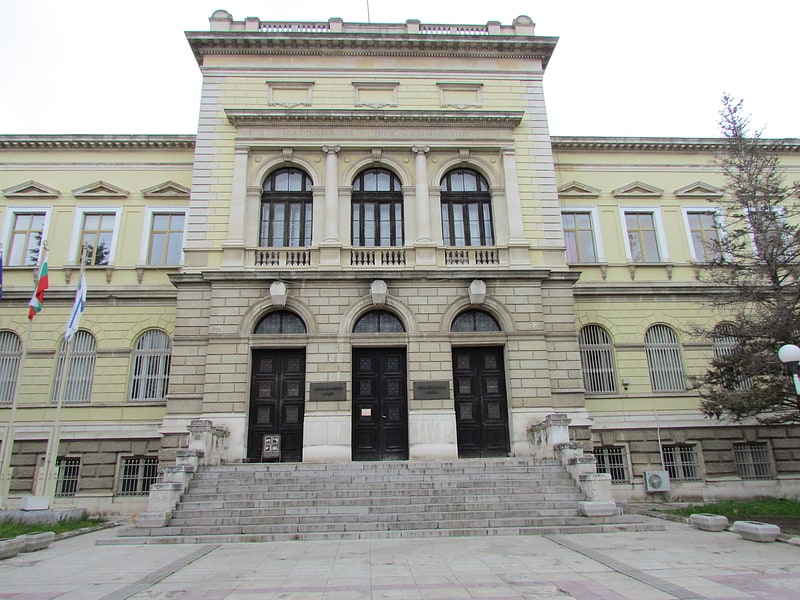
Also known as: Варненски археологически музей
Museum for regional archaeology. The Varna Archaeological Museum is an archaeological museum in the city of Varna on the Black Sea coast of Bulgaria.
Founded on 3 June 1888, when a museum, part of the City Library was established, the Varna Archaeological Museum is situated in a historic building designed in the Neo-Renaissance style by the noted architect Petko Momchilov and built in 1892–1898 for the Varna Girls' School. It became state property in 1945 and since 1993 the museum occupies all of the building, parts of which it has used since 1895.
One of the largest museums in Bulgaria, it features 2,150 m2 of exhibition area and displays objects from the prehistoric, Thracian, Ancient Greek and Ancient Roman periods of the region's history, as well as from the times of the medieval Bulgarian and Byzantine Empires, the Ottoman rule and the Bulgarian National Revival.
The Museum's arguably most celebrated exhibit is the Gold of Varna, the oldest gold treasure in the world, excavated in 1972 and dating to 4600-4200 BCE, which occupies three separate exhibition halls.
The museum also manages two open-air archaeological sites, the large Roman baths in the city centre and the medieval grotto of Aladzha Monastery at Golden Sands Nature Park.
Four other sites are undergoing conservation and will be added to the museum roster: the 4th-5th-century episcopal basilica on Khan Krum Street; the basilica and monastery of the same period at Dzhanavara; the 9th-10th-century Theotokos monastery and scriptorium of the Preslav Literary School at Pchelina; and the Mediaeval fortified settlement of Kastritsi at Euxinograd.
The museum has also a library, a children's study museum, a gift shop, and a cafeteria. Its courtyard lapidarium hosts the annual Varna Summer International Jazz Festival.[4]
Address: бул. „Княгиня Мария Луиза“ 41, 9000 Varna
Roman theatre of Philippopolis, Plovdiv

Also known as: Античен театър
Performance venue at a Roman theater. The Roman theatre of Philippopolis is one of the world's best-preserved ancient Roman theatres, located in the city center of modern Plovdiv, Bulgaria, once the ancient city of Philippopolis. It was constructed in the 1st century AD, probably during the reign of Domitian. The theatre can host between 5,000 and 7,000 spectators and it is currently in use.[5]
Address: Ул."Цар Ивайло 4, 4000 Plovdiv
Tsarevets Fortress, Veliko Turnovo
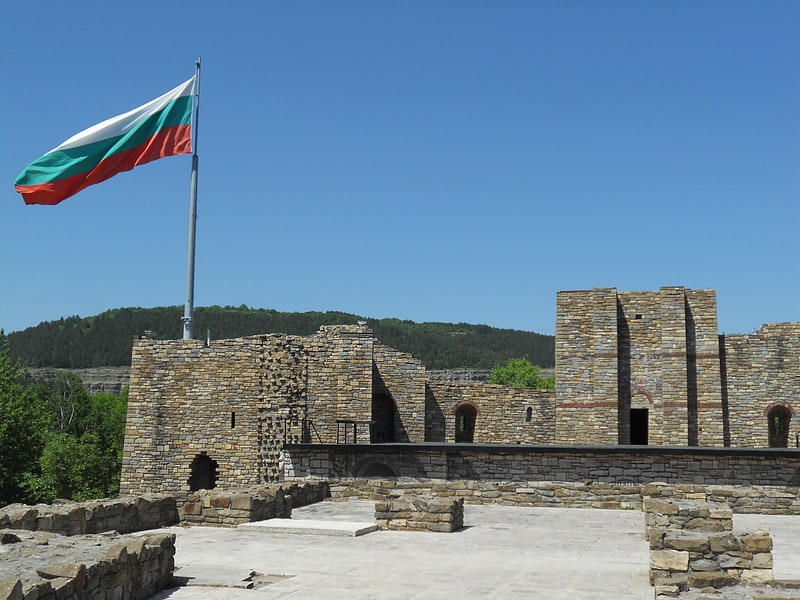
Also known as: Царевец
Grand 12th-century fortress with a show. Tsarevets is a medieval stronghold located on a hill with the same name in Veliko Tarnovo in northern Bulgaria. Tsarevets is 206 metres above sea level. It served as the Second Bulgarian Empire's primary fortress and strongest bulwark between 1185 and 1393, housing the royal and the patriarchal palaces, and it is also a popular tourist attraction.[6]
Address: Велико Търново, Veliko Turnovo
Plovdiv Regional Ethnographic Museum, Plovdiv

Also known as: Регионален етнографски музей
Ornate showcase for Bulgarian culture. The Plovdiv Regional Ethnographic Museum is a museum of ethnography in Plovdiv, Bulgaria. Since 1938, it has occupied the 1847 house of the merchant, Argir Kuyumdzhioglu, in the city's Old Town. The museum features six exhibitions, each occupying a separate room.[7]
Address: ul. "Doctor Stoyan Chomakov" 2, 4000 Plovdiv
Sea Garden, Varna

Also known as: Морска градина
Park in Varna, Bulgaria. The Seaside Garden is the Bulgarian port city of Varna's largest, oldest and best known public park, also said to be the largest landscaped park in the Balkans. Located along the city's coast on the Black Sea, it is an important tourist attraction and a national monument of landscape architecture.
The site where today the Seaside Garden is located was until the middle of the 19th century a bare field outside the city walls. In 1862 a small garden was arranged on the orders of the city's Ottoman mayor. After the Liberation of Bulgaria in 1878 mayor Mihail Koloni suggested the arrangement of a city garden and a seaside park in 1881, and despite suspicions a small sum was granted. As a result the Seaside Garden was expanded to 26,000 m² and further developed according to the plan of French engineer Martinice.
The person primarily associated and regarded as having done most for the garden's modern appearance is the Czech gardener Anton Novák, who had specialized at the Schönbrunn and Belvedere palaces in Vienna, Austria-Hungary. He was invited to work in Varna by his compatriot Karel Škorpil at the request of the municipality in 1894 and arrived in 1895, at the age of 35. One of Varna's best known buildings, the Varna Aquarium, was constructed in the garden in 1906–1911.
During his time in Varna Novák did an immense work: he radically rearranged the garden and ordered the planting of valued plants from the Black Sea and the Mediterranean. His contract with the municipality was extended in 1899, when he was built a house still standing next to the entrance to the garden. The garden gradually grew to reach 90,000 m² in 1905. Several fountains were added in 1912–1913, as well as partially electric lighting. The central alley was decorated with monuments of prominent Bulgarians by a special committee. The seaside casino was built in the 1930s and acquired its modern appearance after a reconstruction in 1960–1961.
The 1930s saw the planting of species from the Netherlands, Germany, the Czech Republic and France, as well as the construction of nursery gardens. The garden was expanded to the south to reach the house of the Italian consul Assaretto, today the Varna Naval Museum. The garden reached its present borders in the 1950s and the trees in the centre of the central alley were substituted with flower beds in the 1960s, which thus reached 20,000 m² in the entire Seaside Garden. In 1939, the architect Georgi Popov designed the garden's modern central entrance with a wide plaza and tall columns.
An Alley of Cosmonauts was arranged in the 1960s, with the first cosmonaut Yuri Gagarin planting the first plant, a silver fir, on 26 May 1961 before a large crowd. The Pantheon of the Perished in the Fight Against Fascism was erected in the same year. The Observatory and Planetarium were opened in 1968 on the site of the old open-air theatre and the Varna Zoo was inaugurated in 1961. A swan-shaped sundial was installed in front of the main entrance. The present open-air theatre, flanked by the Alpineum and the children's amusement park, is the venue of the Varna International Ballet Competition since its inception in 1964, and the dolphinarium was erected in 1984. Recently, the Exotic Zoo terrarium was added, and plans for expansion of the Natural History Museum and the Aquarium were announced. In the park you could also visit the Naval Museum where you could find an interesting display of historic naval objects such as the famous bulgarian Drazki torpedo boat.
The park is the favourite place for recreation and fun of the citizens of Varna. Apart from the long alleys for promenades, the sea coast with the beach and numerous restaurants, bars and clubs, one could also enjoy a swimming pool complex and a children's playing ground with mini-entertainment park and a small pond with boats. Just before the main alley of the garden is situated the so called "bridge of wishes"- a small bridge which is believed to fulfil wishes if you cross it walking backwards and with your eyes closed.[8]
Popovo Lake, Pirin National Park
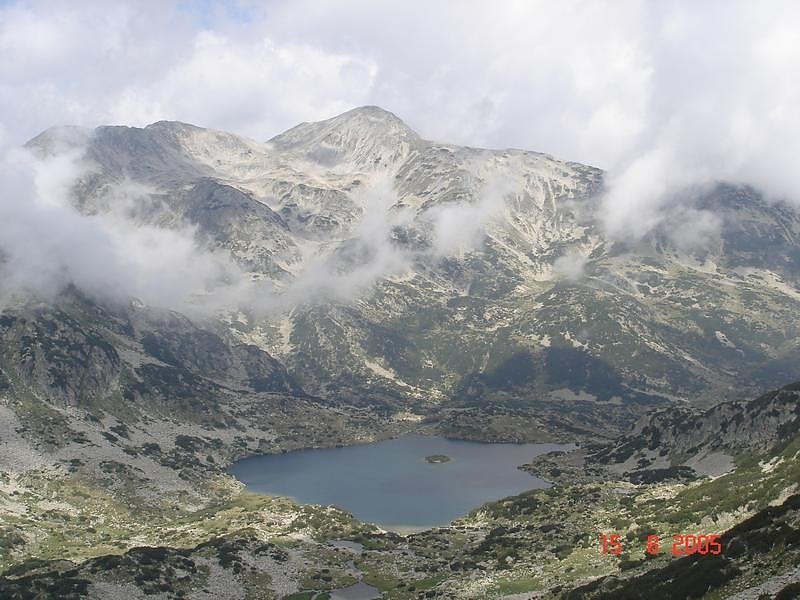
Also known as: Попово езеро
Lake in Bulgaria. The Popovo Lake is a glacial lake situated in the northern section of the Pirin mountain range, south-western Bulgaria. It is one of the eleven Popovi Lakes. The lake and its surroundings are among the most popular places for summer tourism in Pirin National Park. It is situated at the bottom of the Popovski cirque and is surrounded by the peaks Sivria, Dzhano, Kralev Dvor, Momin Dvor and Dzhengal.
The lake is situated at an altitude of 2,234 m. Popovo Lake is Pirin's largest by area and volume, and also the deepest one in the massif. It has the shape of irregular pentagon and features a small islet. The maximum length is 480 m; the width is 336 m. Its surface area is 123,600 m2, which places it fourth among Bulgaria's glacial lakes by total area, after Smradlivo Lake, the Upper Fish Lake and Bliznaka, all of them in the Rila mountain range. It is 29.5 m deep is second in the country after Okoto Lake in Rila, which reaches depth of 37.7 m. Its volume is around 1,270,000 m3. In summer the water temperature reaches 14–16 °C at the surface and decreases to 5–6 °C in the deeper layers.
Popovo Lake takes water from rainfall, snowfall and two tiny springs which pour into the southern end of the lake. The biggest amount of water can be observed in late spring during the snow melting from surrounding peaks. The water that pours out of the lake forms the river Retizhe, a right tributary of the Mesta. The Retizhe flows to the seven Fish Popovski Lakes and drains the whole Popovski cirque. The area around the lake is dotted with meadows and mountain pine (Pinus mugo), whose age is above 100 years at places.
In Bulgarian language the name of the lake means the Lake of the Priest. There are two legends about it origin. According to the more popular one, a priest threw himself into the water because the Ottoman Turks had violated his daughter. His cap surfaced and made the little islet in the middle of the lake. The other legend suggests that after the Christianization of Bulgaria in the 9th century, a priest decided to climb the Pirin mountain and expel the Slavic god Perun. He found him but Perun was enraged by his audacity and threw him into the lake. Again, his cap emerged from the water and formed the islet.[9]
Church of St Stephen, Nesebar

Also known as: Свети Стефан
Museum in Nesebar, Bulgaria. The Church of St. Stephen is a former Eastern Orthodox Church in Nessebar, Eastern Bulgaria, which is now turned into a museum. It is part of architectural and historical reserve in the city, which is part of the UNESCO World Heritage Site and one of the 100 national tourist sites. The building consists of a three-nave basilica with dimensions 12.1 x 9.5 m, and served as the cathedral church of the metropolitan center in the province of Nessebar.
The church has been restored and enlarged several times and is difficult to be dated exactly. The eastern part is the oldest and probably dates from the 11th century. Some centuries later the church was enlarged by adding a new structure to the west. The western wall was demolished and the present narthex was built. The church was timber-roofed. The exterior is rich in design. The eastern and the western façades are crowned with pediments in the form of trefoil arches. The eastern façade is more elaborate. It comprises three high apses, the middle of which rises above the side ones. All three are decorated with ceramic plaques. A colourful effect is achieved by the mixed masonry of stone and bricks, without keeping to any fixed pattern. The decoration of the façade is the reason for defining this church as an example of the ornamental architectural style.[10]
Nesebar Archaeological Museum, Nesebar
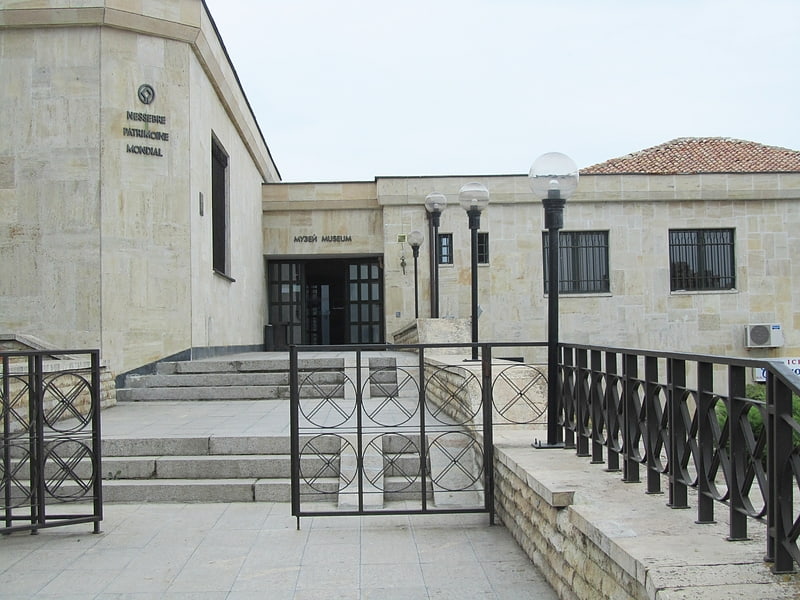
Also known as: Археологически музей, Несебър
Museum in Nesebar, Bulgaria. The Nesebar Archaeological Museum is a museum located in Nesebar, a town on the Black Sea coast of southeast Bulgaria.[11]
Address: ul. "Mesembrija" 2, 8231 Nessebur
Aladzha Monastery, Varna
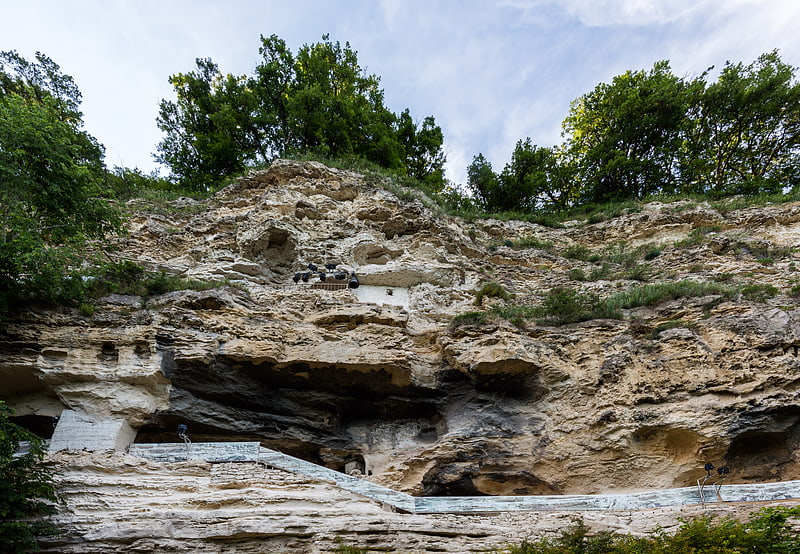
Also known as: Аладжа манастир
Medieval cave monastery in a cliff. Aladzha Monastery is a medieval Orthodox Christian cave monastery complex in northeastern Bulgaria, 17 km north of central Varna and 3 km west of Golden Sands beach resort, in a protected forest area adjacent to the Golden Sands Nature Park.
The monastery caves were hewn into a 25-m high vertical karst cliff near the upper edge of the Franga Plateau on several levels. The complex includes two small nearby catacombs.
Dedicated to the Holy Trinity, it was an active hesychast monastic community of the Second Bulgarian Empire since the 12th century and perhaps survived until the early 18th century. Nearby, remains of a 5th-century cave monastery have been found.
A cave monastery may have existed not far from the modern monastery Aladzha, near Varna. Its early dating to the fourth century is secured by fragments of glassware, but coins of Justinian indicate that the complex may have still been in use during the 500s.
As late as the early 20th century, the forested hills surrounding the monastery and known as Hachuka (Mount of the Cross) or Latin, were regarded by locals as sacred and inhabited by a mythical chthonic daemon treasure keeper, Imri Pop or Rim-Papa.
Today, the grotto is a popular tourist destination. Its present name appeared in the late Ottoman period; Alaca (Turkish for motley) referred to its colourful murals, now almost destroyed. Thematic light shows are being staged in the summer.[12]
Address: In Naturpark, 9000 Varna
Church of Saint Paraskevi, Nesebar
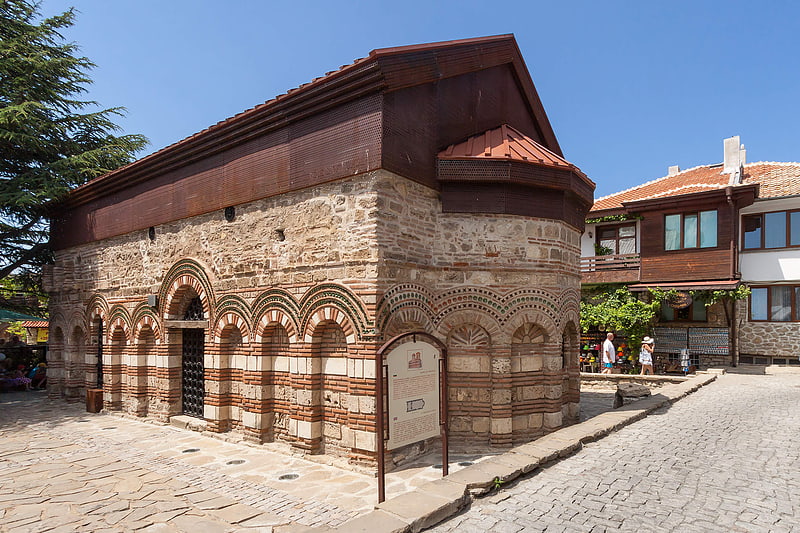
Also known as: Света Параскева
Museum in Nesebar. The Church of Saint Paraskevi is a partially preserved medieval Eastern Orthodox church in Nesebar, a town on the Black Sea coast of Burgas Province in eastern Bulgaria. It was most likely built in the 13th or 14th century and forms part of the Ancient Nesebar UNESCO World Heritage Site. The Church of Saint Paraskevi features a single nave and a pentagonal apse as well as rich exterior decoration. Its dome and the belfry surmounting the narthex have not been preserved today, and it is unknown which of the three saints named Paraskevi it was dedicated to.[13]
Address: Khemus St., 8230 Nessebar
Kralev Dvor, Pirin National Park
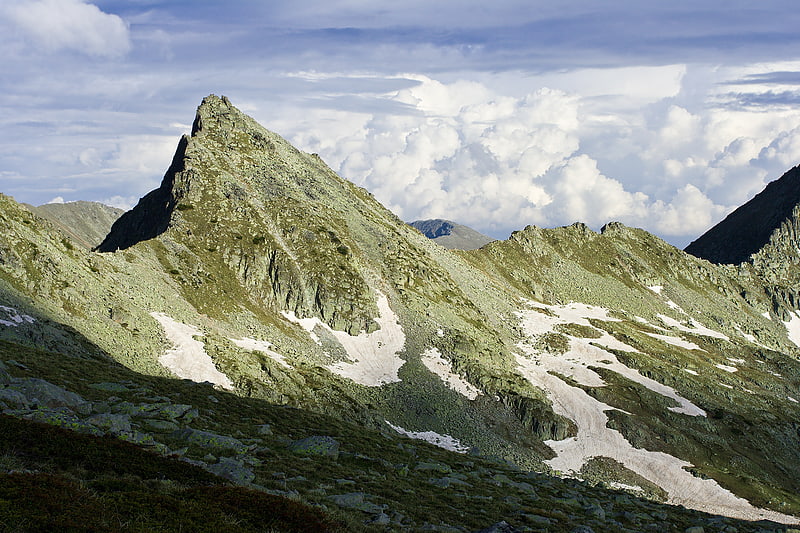
Kralev Dvor is a 2,680 m high peak in the Pirin mountain range, south-western Bulgaria. It is located on the southern part of the main mountain ridge. It is a pyramidal peak formed by cirque erosion by the glaciers in the cirques of Demir Kapia, Kralev Dvor and Belemeto. Seen from Tevnoto Lake, it has a triangular shape leaning in north-northwestern direction. To the north is located another massive pyramid-shaped summit, Momin Dvor. The two peaks are connected via an easily accessible saddle on the main path between the Bezbog refuge and Tevnoto Lake shelter. To the south the Kamenitsa secondary ridge stems from the main mountain ridge with the summits of Malka Kamenitsa and Kamenitsa Peak.[14]
Kamenitsa Peak, Pirin National Park
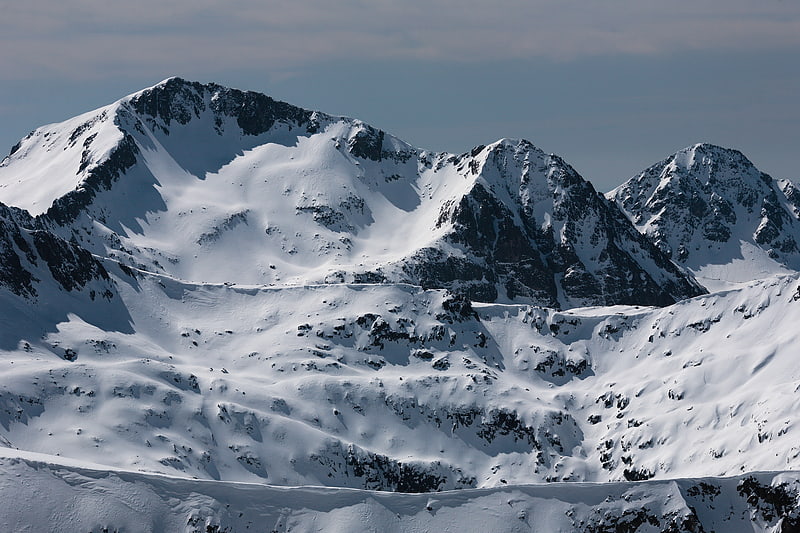
Kamenitsa is a peak in the Pirin mountain range, south-western Bulgaria. It is located in the northern part of Pirin on the 22 km-long Kamenitsa secondary ridge between the summits of Malka Kamenitsa to the north and Yalovarnika to the south. Its height is 2,822 m which ranks it on fifth place in Pirin, behind Vihren, Kutelo, Banski Suhodol and Polezhan. The peak is built up of granite blocks covered in lichens.
A short ridge stems form the summit in western direction, ending with rocky slopes known as the Kamenitsa doll. It is with the Kamenitsa doll that Kamenitsa acquires its characteristic and very popular silhouette seen from Tevnoto Lake. To the south is situated the long Begovishki ridge that separates the valleys of the rivers Begovitsa and Mozgovitsa. To the north the summit is rugged with prominent pointy peak. Below the steep rocks there is a large field of moraines which give the name of the peak. On the northern face there is a climbing tour of category II "b". To the south the peak is rocky but less oblique and imposing.
Kamenitsa is accessible from the Begovitsa and Pirin refuges, as well as from the Tevno ezero shelter. There are no marked tourist paths leading to the summit but the views from the top are among the most impressive in Pirin.[15]
Devingrad, Veliko Turnovo

Fortress in Bulgaria. Momina krepost also called Devingrad is a medieval stronghold located on a hill with the same name in Veliko Tarnovo in northern Bulgaria. This hill was one from the three main hills when Medieval Tarnovgrad was the capital of the Second Bulgarian Empire.[16]
Monument of Liberty, Rousse
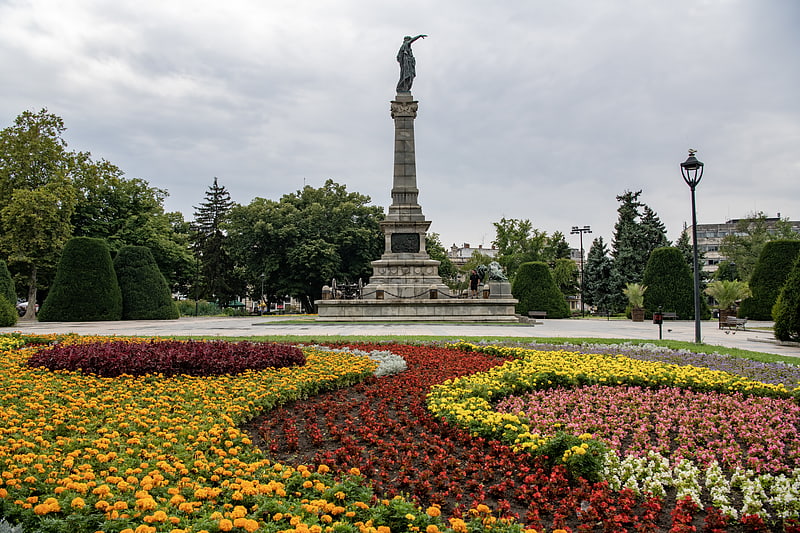
Also known as: Паметник на Свободата
Tourist attraction in Ruse, Bulgaria. The Monument of Liberty in Rousse, Bulgaria, was built at the beginning of the 20th century by the Italian sculptor Arnoldo Zocchi. As time went by, it gained significance as one of the city's symbols, and now forms a part of her coat of arms.[17]
Address: пл. Свобода, 7000 Русе
National Transport Museum, Rousse
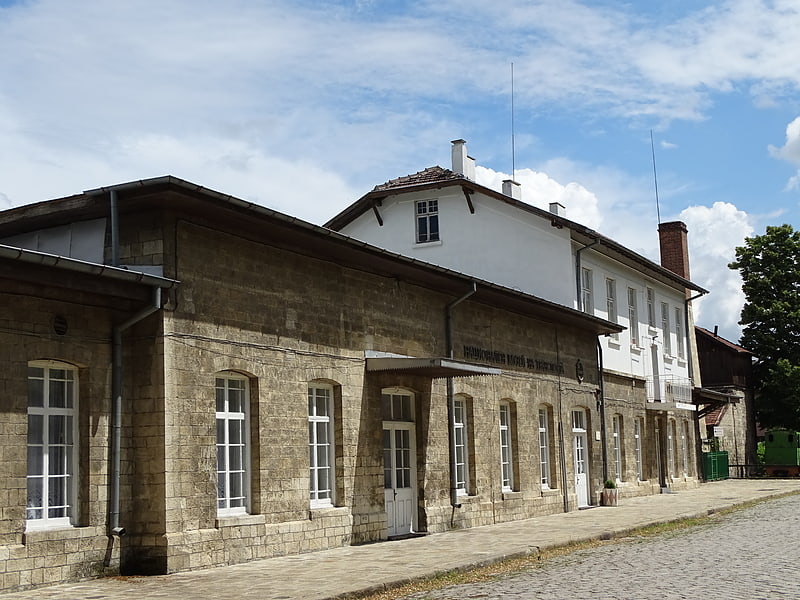
Also known as: Национален музей на транспорта
Museum in Ruse, Bulgaria. The National Transport Museum in Ruse, Bulgaria, is situated on the bank of the Danube, in the country's first railway station, built in 1866.[18]
Address: ul. "Bratya Obretenovi" 5, 7002 Ruse
Holy Forty Martyrs Church, Veliko Turnovo
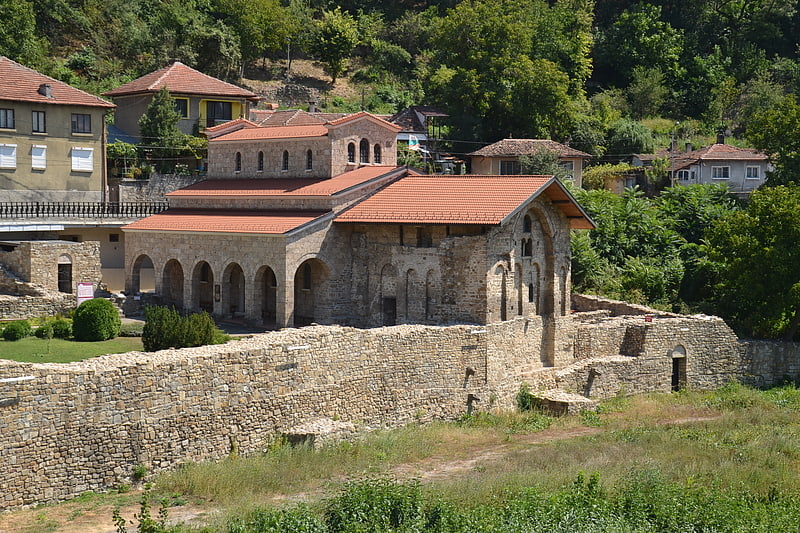
Also known as: Свети Четиридесет мъченици
Basilica in Veliko Tarnovo, Bulgaria. The Holy Forty Martyrs Church is a medieval Eastern Orthodox church constructed in 1230 in the town of Veliko Tarnovo in Bulgaria, the former capital of the Second Bulgarian Empire.
The Holy Forty Martyrs Church, an elongated six-columned basilica, has three semicircular apses and a narrow narthex from the west. Another building was added later to the west side of the church. The church interior was covered with mural painting probably in 1230. On the western addition some of the outer decoration survived revealing the traditional arches and coloured small ceramic plates inserted into the wall. It is not clear if the church has frescoes painted on the outer walls.
The church contains some of the Bulgarian Empire's most significant historical records, including Omurtag's Column, Asen's Column and the Border Column from Rodosto from the rule of Khan Krum. The columns of Khan Omurtag and Khan Krum are written in the Greek language. The inscription of the column of Krum "Fortress of Rodostro" has been turned upside down. The inscription of Omurtag is about the building of a new glorious palace on the Danube river, but its location is unknown. The second part of the inscription is a legacy for following generations to remember the deeds of Omurtag. These columns were placed in the church by Ivan Asen II as a tribute to his mighty ancestors.[19]
CACAO BEACH, Sunny Beach

Beach, Night club
Address: Южен плаж, Sunny Beach
Church of St Constantine and Helena, Plovdiv
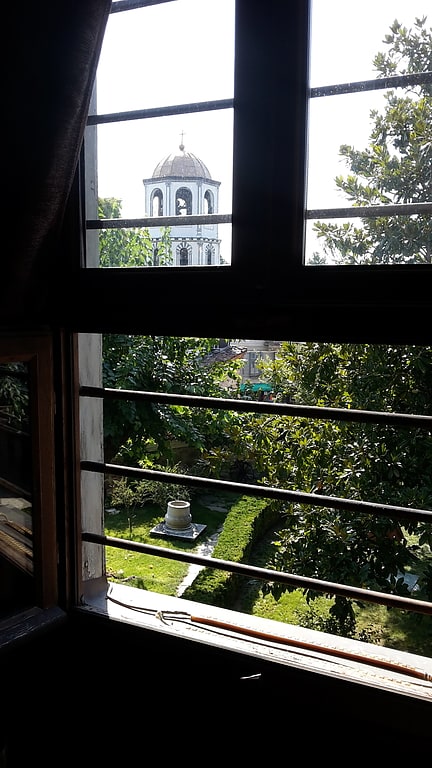
Also known as: Св. св. Константин и Елена
Building in Plovdiv, Bulgaria. The Church of St Constantine and Helena is a church in Plovdiv, Bulgaria. It is considered to be among the oldest churches in the city. It was built in 337 at the sight of an ancient pagan temple in the acropolis on one of the fortified hills. The church was named after Emperor Constantine the Great and his mother Elena. During the years, the building was destroyed and rebuilt several times. Its current edifice was constructed in 1832 with the help of local patriots. Its magnificent frescoes and icons were painted by masters of one of the most famous Bulgarian Icongraphic Schools: the Debar School. Some of the icons and painting of the church were made by the famous Bulgarian National Revival painter Zahari Zograf who lived and worked in Plovdiv between 1836 and 1840.[20]
Rousse Regional Historical Museum, Rousse
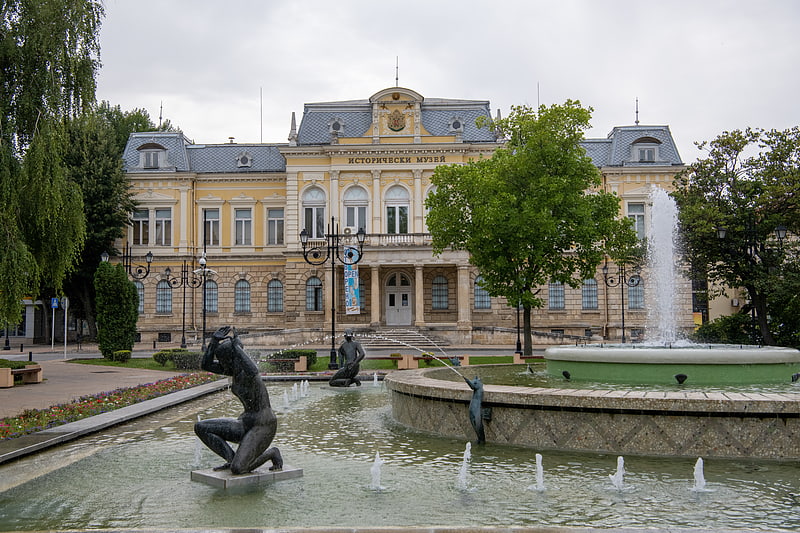
Also known as: Регионален исторически музей
Museum of regional art and history. The Rousse Regional Historical Museum is one of the 11 regional museums of Bulgaria. It acts within the Rousse, Razgrad, and Silistra regions. The museum occupies the building of the former Battenberg Palace, previously a local court, built 1879–1882 by Friedrich Grünanger.
The Rousse Regional Historical Museum was established in 1904. Its basis are the archeological collections of Karel and Hermenguild Shkorpil, as well as of the naturalist Vasil Kovachev, which were gathered in the "Knyaz Boris" men's high school of Rousse.[21]
Address: Alexander Battenberg Square 3, 7000 Ruse
Vihren, Bansko
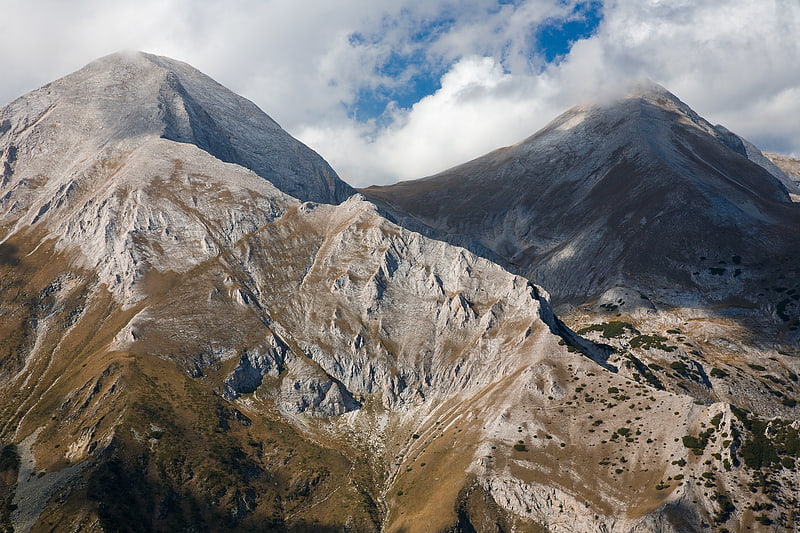
Also known as: Вихрен
Peak in Bulgaria. Vihren is the highest peak of Bulgaria's Pirin Mountains. Reaching 2,914 metres, it is Bulgaria's second and the Balkans' third highest, after Musala and Mount Olympus. Although due to the karst topography Vihren is deprived of lakes and streams, a number of Pirin's lakes are located around the peak, as is Europe's southernmost glacial mass, the Snezhnika glacieret. Until 1942 Vihren was known as Eltepe; it was also called Buren and Malnienosets. The UNESCO World Heritage Site Pirin National Park was originally known as the Vihren National Park. Vihren is included in the 100 Tourist Sites of Bulgaria under No. 2.[22]
Musala, Rila National Park

Also known as: Мусала
Peak in Bulgaria. Musala; from Arabic through Ottoman Turkish: from Musalla, "near God" or "place for prayer" is the highest peak in the Rila Mountains, as well as in Bulgaria and the entire Balkan Peninsula, standing at 2,925 metres. With a topographic prominence of 2,473 metres, Musala is also the 6th highest peak by topographic prominence in mainland Europe. Musala is also the 3rd most topographically isolated major peak in Continental Europe.
Musala is situated within the Rila National Park, which is noted for its rich flora, including species such as Macedonian Pine and Bulgarian Fir in the forests on its middle slopes, and fauna; it is one of the easiest places in Europe to see the wallcreeper. All major mountain ranges of Bulgaria can be seen from the top; these include Vitosha to the northwest, Sredna Gora towards the northeast, the Balkan Mountains along most of the northern horizon behind Vitosha and Sredna Gora, the Rhodope Mountains to the southeast, Pirin to the south, Osogovo and Ruy Mountain to the west, and of course, the rest of Rila.
A cosmic ray station was built on the peak in 1960 with cooperation from the Hungarian Academy of Science. The station conducted scientific experiments using a muon telescope. The station was destroyed by an electrical fire on October 29, 1983.
With an average annual temperature of -2.3 °C Musala is the coldest place in Bulgaria and the entire Balkan Peninsula. Temperatures stay below 0 °C for about 8 months each year. Due to this about 45% of the annual precipitation on Musala is snow, and snow cover lasts for about 200 days (more than six months). Three of the main rivers of Bulgaria, the Iskar, Maritsa and Mesta have their sources near Musala.
The next highest peaks in the vicinity of Musala are Malka (Little) Musala (2,902 metres (9,521 ft)) and Irechek (2,852 metres (9,357 ft)).[23]
Baba Vida, Vidin
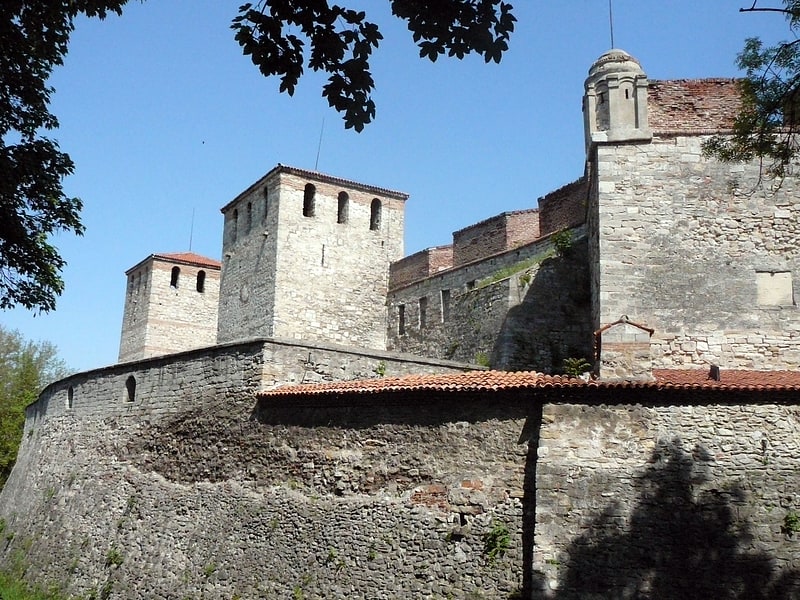
Also known as: Баба Вида
Fortress in Vidin, Bulgaria. Baba Vida is a medieval fortress in Vidin in northwestern Bulgaria and the town's primary landmark. It consists of two concentric curtain walls and about nine towers of which three are preserved to their full medieval height, including the original battlements, and is said to be the only entirely preserved medieval castle in the country. Baba Vida is 39 metres above sea level.
The construction of the fortress began in the 10th century at the place of the Ancient Roman castell Bononia. The building of Baba Vida is tied to a legend, according to which a Danubian Bulgarian king who ruled at Vidin had three daughters: Vida, Kula and Gamza. Prior to his death, he divided his realm among the three. Vida, the eldest, was given Vidin and the lands north to the Carpathians, Kula was awarded Zaječar and the Timok Valley, and Gamza was to rule the lands west up to the Morava. Although Gamza and Kula married to drunkard and warlike nobles, Vida remained unmarried and built the fortress in her city. The name of the castle means "Granny Vida".
Baba Vida served as Vidin's main defensive installation during the course of the Middle Ages and acted as the most important fortress of northwestern Bulgaria. The Baba Vida stronghold withstood an eight-month-long siege by Byzantine forces led by Basil II, but was destroyed and once again erected during the rule of Ivan Stratsimir (1356-1396), as whose capital it served. Between 1365 and 1369, the fortress was in Hungarian hands. Vidin was suddenly attacked by the forces of Louis I of Hungary, but it took several months to conquer Baba Vida. In 1369, Ivan Sratsimir managed to regain control of his capital, albeit having to remain under Hungarian overlordship.
In 1388, the Ottomans invaded Sratsimir's lands and forced him to become their vassal. In 1396, he joined an anti-Ottoman crusade led by the King of Hungary, Sigismund, placing his resources at the crusaders' disposal. The crusade ended in the disastrous Battle of Nicopolis at Nikopol, Bulgaria, with the Ottomans capturing most of Sratsimir's domains shortly thereafter, in 1397.
The fortress played a role during the Ottoman rule of Bulgaria, serving as a weapon warehouse and a prison, also as residence for Osman Pazvantoğlu, and it has been no longer used for defensive purposes since the end of the 18th century.
Today, Baba Vida castle functions as a museum. Being a popular tourist attraction, the fortress is being kept in repair.[24]
Address: в Крайдунавския парк, Vidin
Rozhen Monastery, Melnik
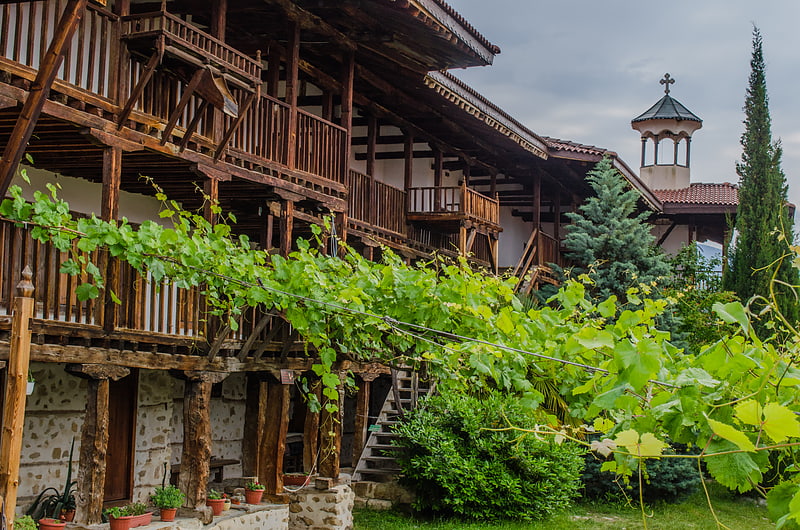
Also known as: Роженски манастир
Monastery in Bulgaria. The Rozhen Monastery of the Nativity of the Mother of God is the biggest monastery in the Pirin Mountains in southwestern Bulgaria, nestled in the Melnik Earth Pyramids. It is one of the few medieval Bulgarian monasteries well preserved until today.
The earliest archaeological evidence of medieval life at the place is a grave with a few coins and decorations from the time of Byzantine Emperor Michael VIII Palaiologos (1259–1282). Some other items also date to the 13th century while the marble frieze above the central gate of the church dates to the 13th or 14th century. A couple of new buildings were constructed in the monastery at the time of Despot Alexius Slav. The earliest written source testifying to the monastery's existence is a note on a chant book from 1551, today in the Great Lavra library on Mount Athos.
The monastery church was built before the 15th century and painted in 1597; some of those frescoes are preserved. In 1611, the south facade was painted. The Rozhen Monastery was devastated by fire between 1662 and 1674, destroying the library and severely damaging most buildings. The monastery was restored over the next century with the financial help of rich Bulgarians from the whole country. The reconstruction began in 1715 and was fully finished in 1732.
The monastery reached its apogee in the 19th century, when it was a regional centre of Orthodox Christianity and owned a lot of land in the area. Famous Bulgarian revolutionary Yane Sandanski's grave is located near the monastery.[25]
Kordopulov House, Melnik
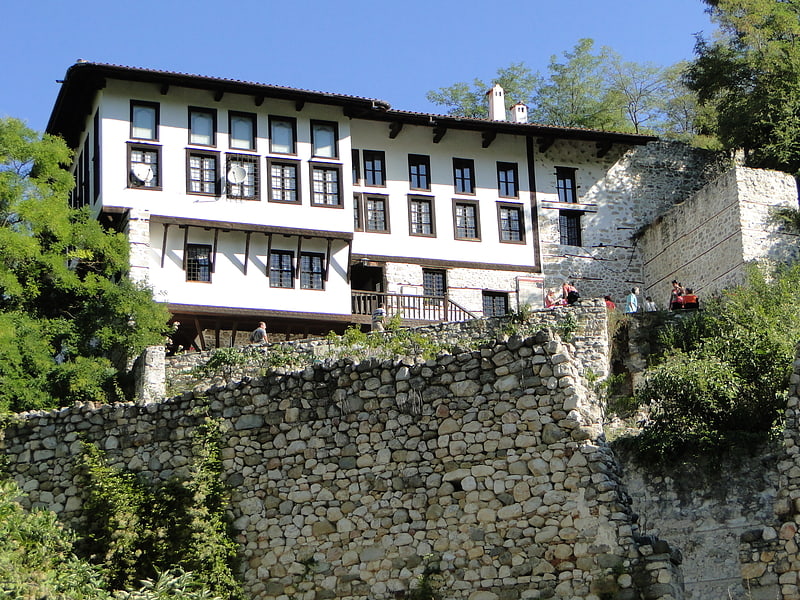
Also known as: Кордопулова къща
Museum in Melnik, Bulgaria. The Kordopulov House is a large Bulgarian National Revival house in the southwestern Bulgarian town of Melnik. It was built in 1754 specifically for wine production and was bought by the rich and known merchant Manolis Kordopulos. The house, possibly the largest of its kind and period, is located in the town's eastern part and consists of a ground floor that includes a wine cellar, a semi-basement for economic needs and a bay floor intended to be inhabited.[26]
Address: 47 ул. Мелник, Melnik
Ledenika, Vratsa
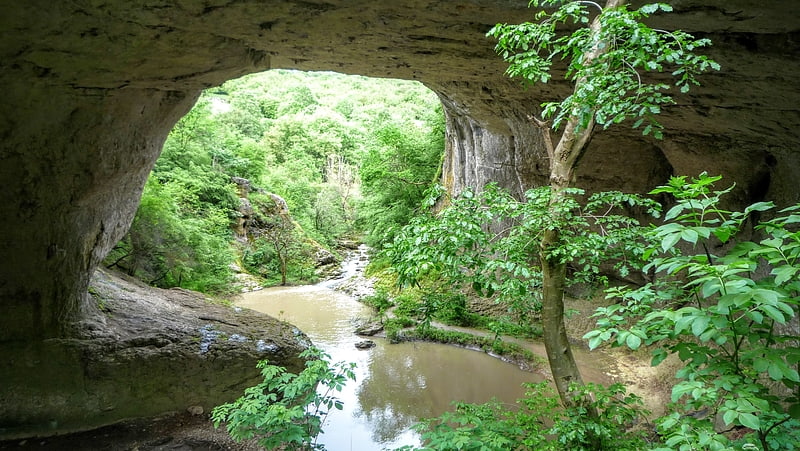
Also known as: Леденика
Cave. Ledenika is a cave in the Northwestern parts of the Balkan Mountains, 16 km away from the Bulgarian city of Vratsa. Its entrance is approximately 830 m above sea level. The cave features an abundance of galleries and impressive karst formations including stalactites and stalagmites. It was first discovered around the beginning of the 20th century and has been open to tourists since 1961. Ledenika Peak on Graham Land in Antarctica is named after the cave, in recognition of its cultural importance.[27]
Address: на 16 км. от гр. Враца, 3000 Враца
Etar Architectural-Ethnographic Complex, Gabrovo
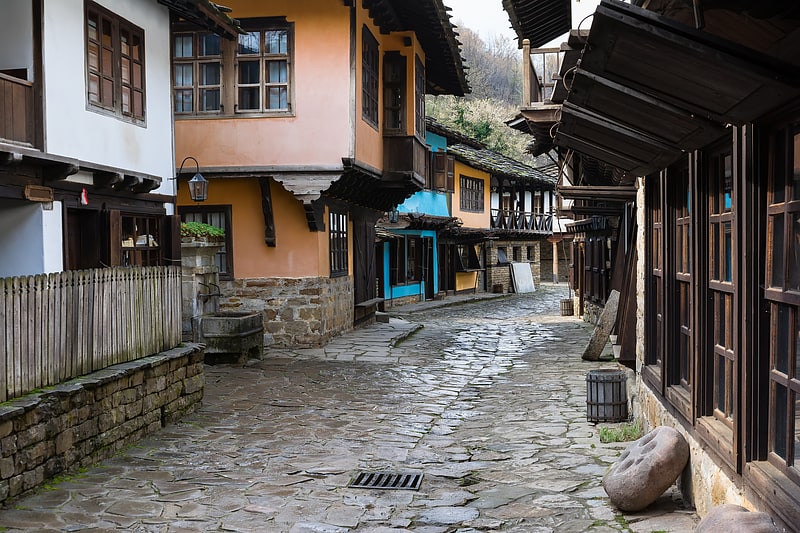
Also known as: Етър
Museum in Bulgaria. The Open Air Ethnographic Museum «Etar» is an open-air museum and a neighbourhood of Gabrovo in northern Bulgaria. It is on the northern edge of the Bulgarka Nature Park, between the park and the city of Gabrovo.
It presents the Bulgarian customs, culture and craftsmanship. It spans over an area of 7 ha and contains a total of 50 objects, including water installations and houses with craftsmen's workshops attached. As a whole, the complex's goal is to illustrate the architecture, way of life and economy of Gabrovo and the region during the Bulgarian National Revival.
The museum's construction started in 1963 under the direction and project of Lazar Donkov. The pre-existing Karadzheyka water-mill, built around 1780, was thoroughly reconstructed, with the other objects being constructed later. The complex was opened on 7 September 1964 and proclaimed a national park in 1967, as well as a monument of culture in 1971.
The park features typical Bulgarian revival houses with two floors, bay windows, a clock tower, and a beautifully decorated house by Saakov featuring 21 windows. Using original instruments and following the old traditions, locals represent around 20 characteristics of the regional crafts such as wood-carving, pottery, coppersmith crafts, furriery, cutlery making, needlework etc. There are shops for souvenirs. There are numerous restaurants in the park where tourist could consume local Bulgarian cuisine. There are visitors to the park, from all over the world, all the year round, especially during the annual Christian festivals celebrated in the park, namely, Palm Sunday and Easter.
Sokolski Monastery is situated several kilometers away from Etar.[28]
Crown Exchange - Sunny Beach - Bulgaria, Sunny Beach

Beach, Outdoor activities, Park, Go kart
Address: Main Road E87 Bourgas-Varna, 8000 Sunny Beach
Pleven Panorama, Pleven
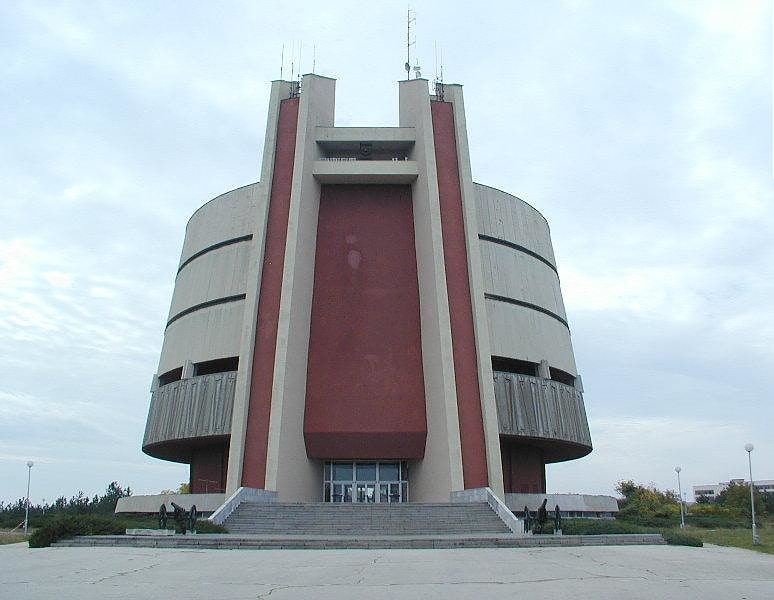
Also known as: Панорама „Плевенска епопея 1877 г.“
Monument in Bulgaria. Pleven Epopee 1877, more commonly known as Pleven Panorama, is a panorama located in Pleven, Bulgaria, that depicts the events of the Russian-Turkish War of 1877–78, specifically the five-month Siege of Plevna which made the city internationally famous and which contributed to the Liberation of Bulgaria after five centuries of Ottoman rule.
The panorama was created by 13 Russian and Bulgarian artists and was constructed in honor of the 100th anniversary of the Pleven Epopee and was officially unveiled on 10 December 1977. The panorama expanded the already existing Skobelev Park, which is the site of three of the four major battles which led to the liberation of Bulgaria. In the first three years after its opening, 2.5 million people visited the panorama. The monument is one of nearly 200 built by the people of Pleven in tribute to the battle and to the nearly 35,000 lives lost.[29]
Address: ул. Мур, 5000 Плевен
Malka Musala, Rila National Park

Malka Musala is a summit in the eastern part of the Rila Mountain in southwestern Bulgaria. With an altitude of 2,902 m, it is the second highest peak in Rila after Musala, fourth in Bulgaria behind Vihren and Kutelo in the Pirin Mountain, and seventh in the Balkan Peninsula.
The summit is situated to the north-east of Musala, separated by a rocky ridge. The ridge extends in north-eastern direction to the summits of Irechek (2,852 m) and Deno (2,790 m). To the north-west is located the Musala Cirque and the highest of the seven Musala Lakes. To the south and the east the slopes of Malka Musala descend to the deep valley of the Maritsa River, forming two cirques. The cirque between Malka Musala and Musala is waterless, the one between Malka Musala and Irechek nestles a glacial lake that gives the source of a stream that flows to the Maritsa.
Between 1950 and 1989 Malka Musala was officially named Dimitov, after the Bulgarian communist leader Georgi Dimitrov.[30]
Malyovitsa, Rila National Park
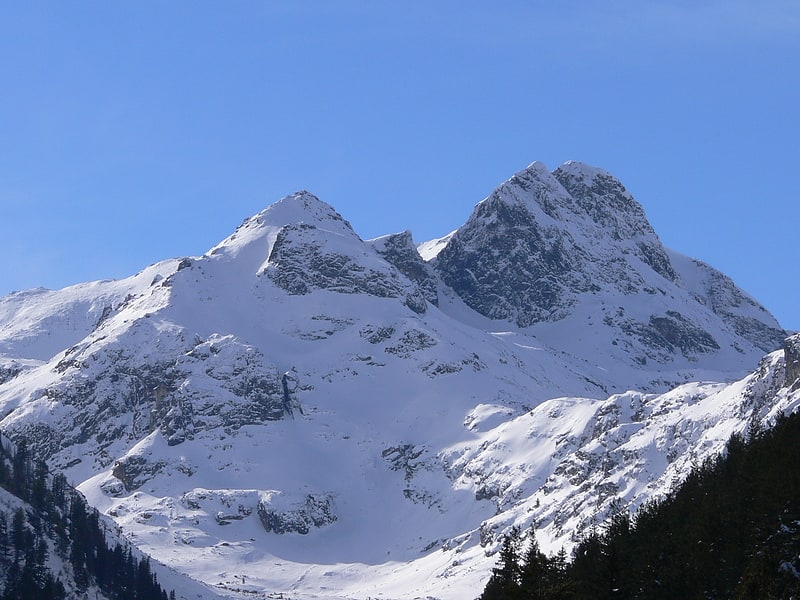
Also known as: Мальовица
Peak in Bulgaria. Malyovitsa is a peak in the northwestern part of the Rila Mountain in southwestern Bulgaria. It is 2,729 m high and is one of the most popular tourist regions in the mountain. Its northern and eastern slopes are steep and almost inaccessible while the southern and south-western slopes are more oblique. The Rila Monastery is situated at its southern foothills facing the valley of the Rilska River, and Malyovitsa Ski Centre — with two downhill tracks and two ski drags — is to the north. The main starting point for treks in the region is Malyovitsa Hut at an altitude of 1,700 m at about 2 hours walk from the top of the summit. The three Malyovishki Lakes are situated to the north of the summit, while to the southeast the Elenski Lakes, also three, are located in a deep cirque.
The Malyovitsa region is the cradle of Bulgarian rock climbing and mountaineering. The first organized expeditions were made in 1921–22 by tourists from the town of Samokov. The imposant north wall of the summit was first climbed in 1938 by Konstantin Savadzhiev and Georgi Stoimenov (about 200 m, grade UIAA V+). That was the greatest success of Bulgarian climbers for its time and is deemed birth of Bulgarian alpine mountaineering. Later other walls in the region were climbed too with the most difficult routes being made in the 1970s. In the last 15 years, Malyovitsa region has become very attractive rock-climbing district with the possibilities it gives for mountaineering and sport rock climbing.
Other interesting walls and summits in the vicinity are: Zlia Zab (200 m wall with one of the most famous climbing routes in the country — Vezhdite), Dvuglav (a 450 m high wall, with climbing routes often over 500 m long), Iglata, Dyavolski Igli (several aretes with the hardest climbs in the region), Ushite and others. A wall that is available for less experienced rock-climbers is "Kuklata". It is situated across Malyovitsa Hut, 10 minutes walking, and the main part of its tours is bolted.
Malyovitsa Crag on Livingston Island in the South Shetland Islands, Antarctica is named after Malyovitsa.[31]
Archaeological Museum - Burgas, Burgas
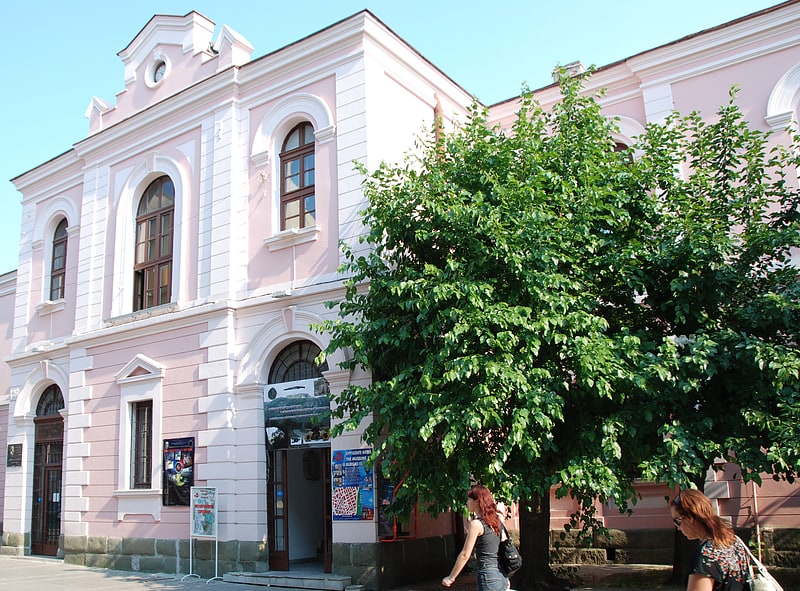
Also known as: Археологически музей
Museum in Burgas, Bulgaria. Archaeological Museum is the oldest museum in Burgas, preserving the cultural and historical heritage of some of the most ancient towns in the present Bulgarian territory - Sozopol, Nessebar, Pomorie and others.
Today the Archaeological museum is one of the four expositions in Regional historical museum Burgas. The museum was established in 1912 as a private museum of the Debelt Archaeological Society. The exposition presents collections of archaeological findings related to ancient Thrace, the Greek colonies along the Black Sea coast and the time of the Roman Empire. In the halls of the museum can be seen exhibits found in archaeological research in the entire Burgas region. Here is the earliest statue ever found on the Bulgarian lands and one of the most complete collections of pre-monetary forms in the country and on the Balkans.[32]
Address: 21 Bogorodi Str, Burgas
Melnik Earth Pyramids, Melnik
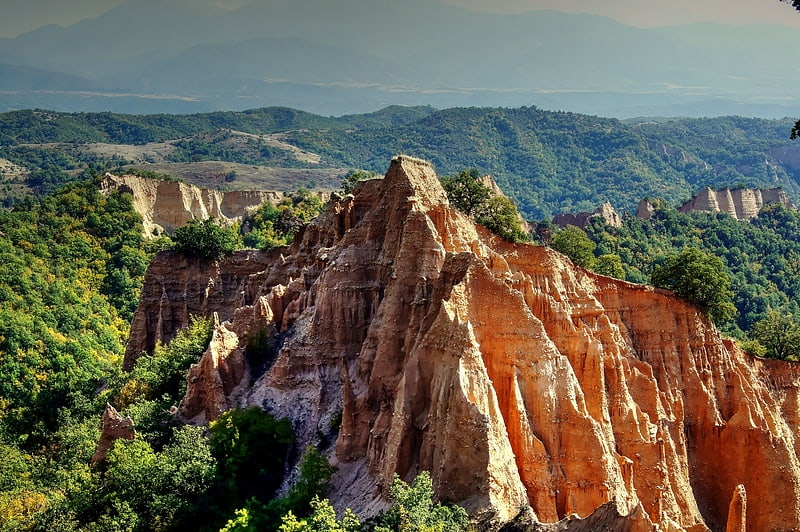
The Melnik Earth Pyramids are rock formations, known as hoodoos, situated at the foothills of the Pirin mountain range in south-western Bulgaria. They span an area of 17 km2 near the town of Melnik, Blagoevgrad Province. Reaching a height of up to 100 m these sandstone pyramids are shaped in forms, resembling giant mushrooms, ancient towers and obelisks. They were formed primarily due to erosion from rainfall and bedrock wear. The Melnik Earth Pyramids are a geological phenomenon of global importance and were declared a natural landmark in 1960. The rock formations are home to rich flora and fauna heavily influenced by the Mediterranean climate. They are a tourist destination due to the natural environment of the area, the cultural sights of Melnik and the Rozhen Monastery.[33]
Sea Garden, Burgas
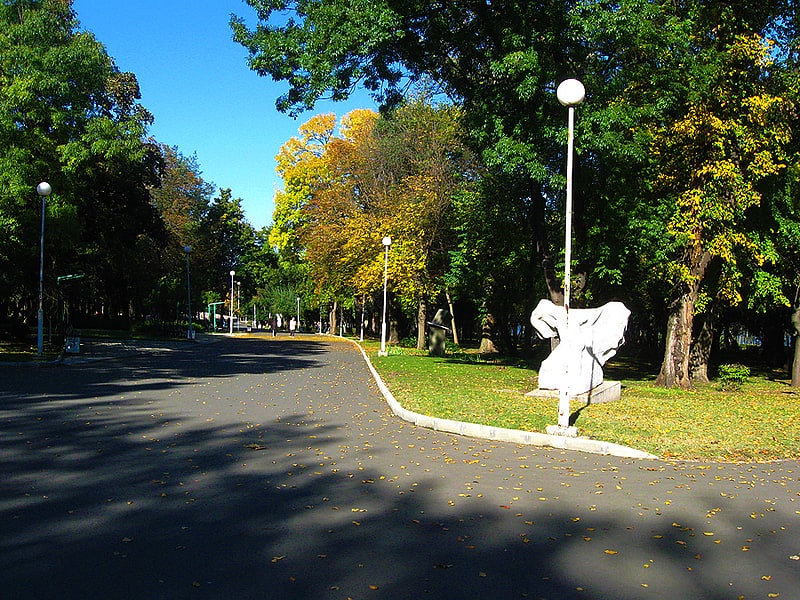
Also known as: Морска градина
Park in Burgas, Bulgaria. The Sea Garden is the Bulgarian port city of Burgas' largest and best known public park. It is located along the city's coast on the Black Sea and it is an important tourist attraction and a national monument of landscape architecture on the Balkans.
Near the Sea Garden is located one of the most popular district of Burgas - district of Lazur. The area of the park is around 800 decares. The park is planted with trees and shrubs. In those areas there are many sculptures sparsed around. The most important monument probably is the monument of Alexander Pushkin.[34]
House of Humour and Satire, Gabrovo
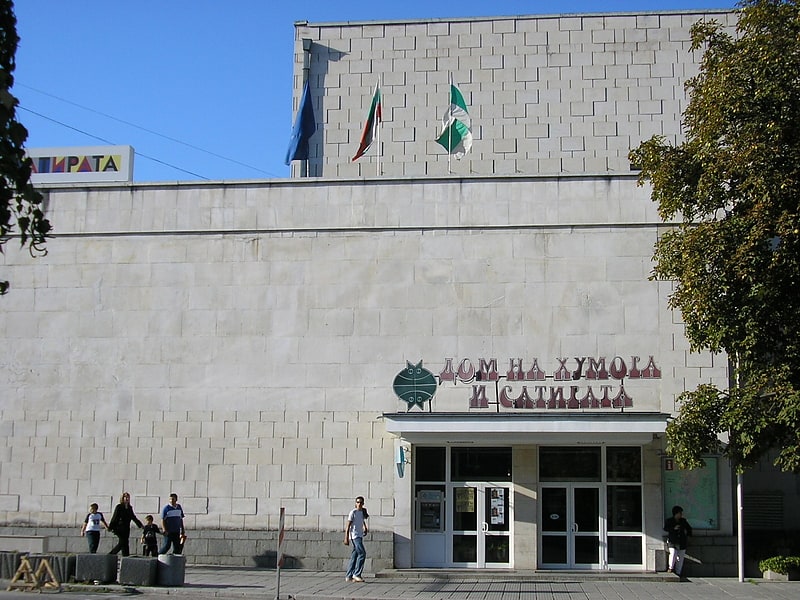
Also known as: Дом на хумора и сатирата
Museum in Gabrovo, Bulgaria. The House of Humour and Satire in Gabrovo, Bulgaria, is an exposition of traditional local humour art, including cartoons, photographs, paintings, sculptures, and verbal humour. The House combines features of a museum and an art gallery. The city of Gabrovo is also known as an international capital of humour and satire. Its motto is "The world lasts because it laughs".[35]
Address: Bryanska St. 68, 5300 Gabrovo
Pleven Regional Historical Museum, Pleven
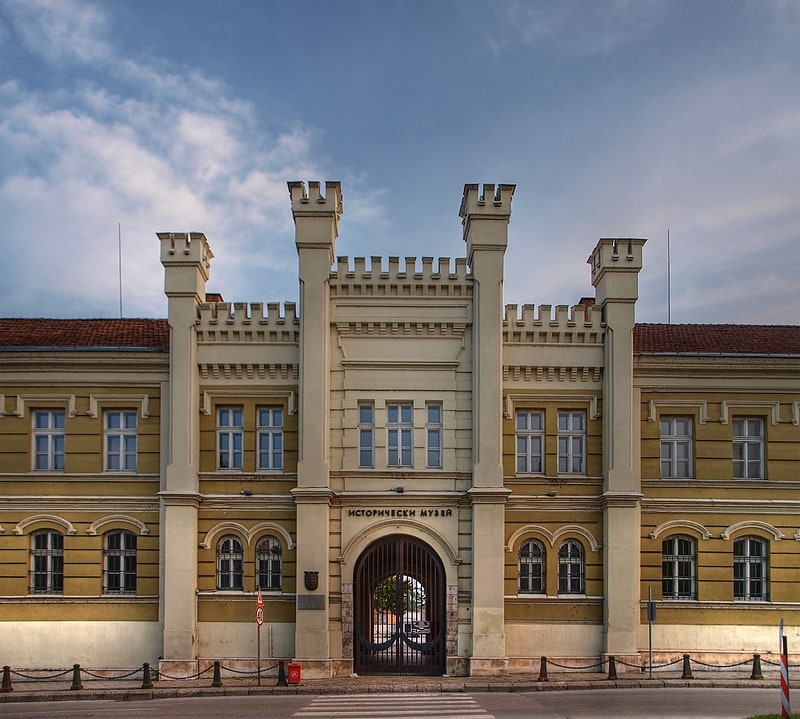
Also known as: Регионален исторически музей
Museum in Pleven, Bulgaria. The Pleven Regional Historical Museum, founded in 1953, is one of the largest museums in Bulgaria. The museum is situated in a two-story edifice near the centre of Pleven that is a monument of culture of national importance and has an area of 7,000 m². Its main stock includes over 180,000 units and the museum library houses over 10,000 volumes of scientific literature and periodicals.[36]
Address: Stoyan Zaimov Str 3, 5800 Pleven
Borov Kamak, Vratsa
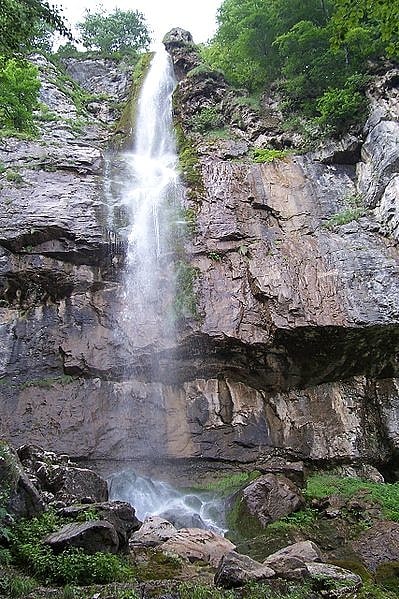
Also known as: Боров камък
Waterfall in Bulgaria. Borov Kamak is a waterfall in the Vratsa mountain, western Balkan Mountains, Bulgaria. The waterfall is situated on one the tributaries of the river Leva which flows through Vratsa. It is located on the territory of Vrachanski Balkan Nature Park. The waterfall is 63 m high.[37]
St George the Conqueror Chapel Mausoleum, Pleven
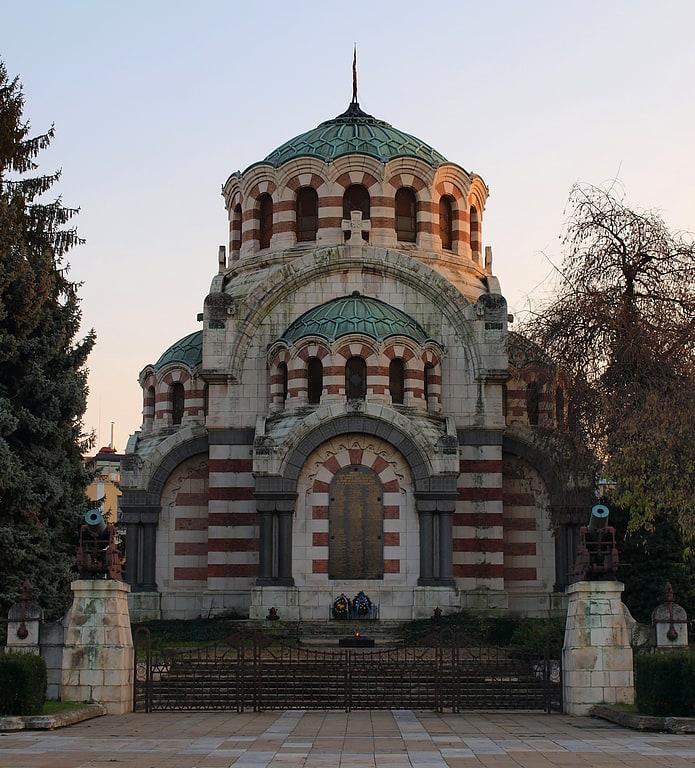
Also known as: Свети Георги
Mausoleum. The St George the Conqueror Chapel Mausoleum is a mausoleum and memorial Bulgarian Orthodox chapel, as well as a major landmark of Pleven, Bulgaria.
Built between 1903 and 1907 in the Neo-Byzantine style by the architect P. Koychev, whose project won a contest in 1903, it is dedicated to the Russian and Romanian soldiers who fell for the Liberation of Bulgaria during the Siege of Plevna of 1877. The remains of many of these soldiers are preserved in the mausoleum. The icons in the chapel mausoleum are the work of Bulgarian artists.
The chapel mausoleum bears the name of Saint George, the patron saint of soldiers, and is also depicted in the coat of arms of Pleven. It lies on the main Vazrazhdane Square.[38]
Address: пл. Възраждане, 5000 Плевен
Museum House of Neofit Rilski, Bansko
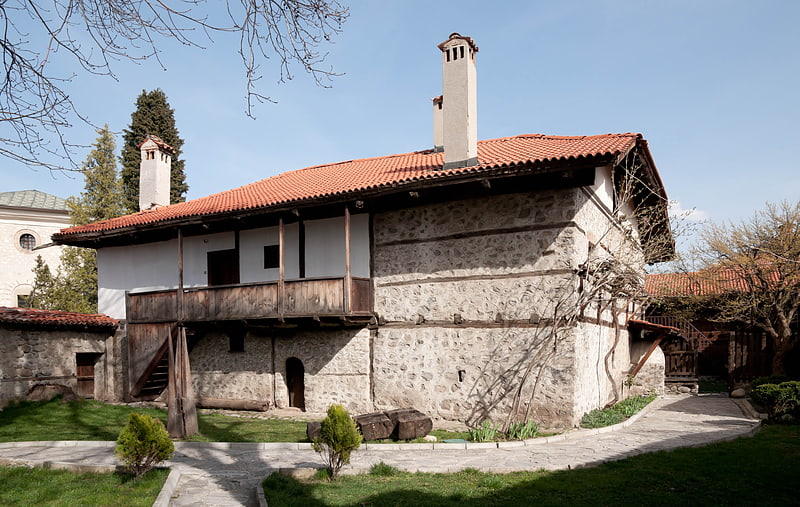
House of the Museum of the Neophyte Riłski - a house in Bansko, Bulgaria, the birthplace of Nikola Benin, known as the Riłski neophyte, the Bulgarian Orthodox monk, an activist in the fight for the Independent Bulgarian Church, one of the leading figures of the Bulgarian national revival. The building is an architectural and historical monument of national culture. It is on the list of 100 domestic tourist attractions.
Paisij Hilendarski, Bansko
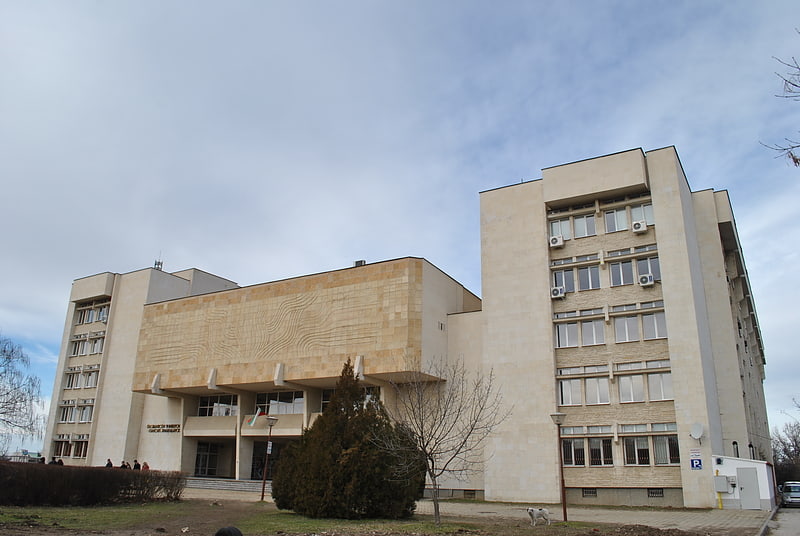
Museum
Address: Отец Паисий, Bansko
Bistreshky Monastery, Vratsa
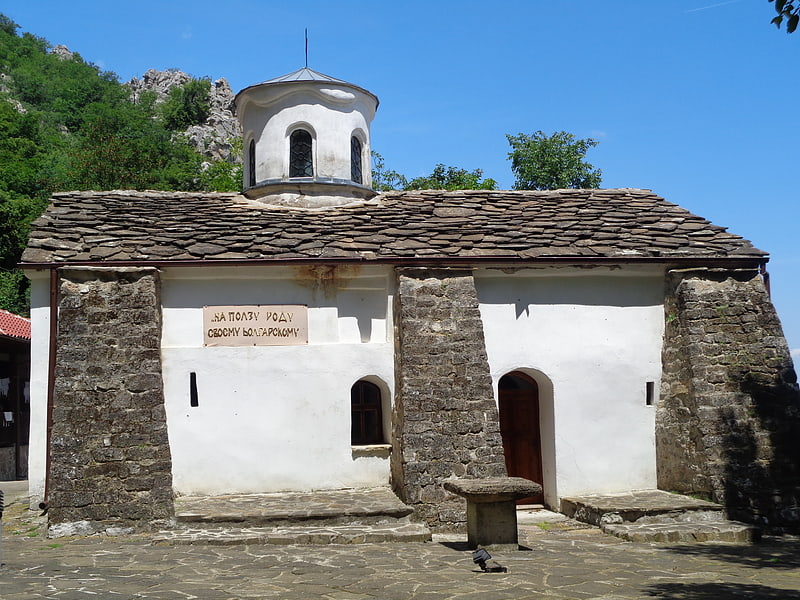
Monastery. Bistreshky Moastery or Monastery of Saint Ivan Kasinets is medieval Bulgarian monastery located in Vratsa Province. Some of the frescoes in the church show that it was restored in the 16th century, but the establishment of the monastery dates back to the era of the Second Bulgarian Kingdom. There was a medieval fortress near the monastery—the fortress Kasina from the 12th to the 14th centuries. In 1822 the first printing workshop for icons in Bulgaria worked in the monastery.[39]
Krastata Kazarma, Vidin

Also known as: Кръстата казарма
Museum in Vidin, Bulgaria. The Krastata Kazarma is a former military facility of the Ottoman Empire. The barracks got its name due to its cross-shaped architecture. It is one of the cultural memorials of the region of Vidin, Bulgaria, today.
The building, constructed by Polish architects, was finished in 1801. It was used by four separate units, also by a unit of the Janissaries.
After liberation the building was used as court of law and as an accommodation building by the Bulgarian army. Today it houses the ethnographical section of the "Konaka" Museum.[40]
Address: Knyaz Boris I St. 34, 3700 Vidin
Stob Earth Pyramids, Blagoevgrad
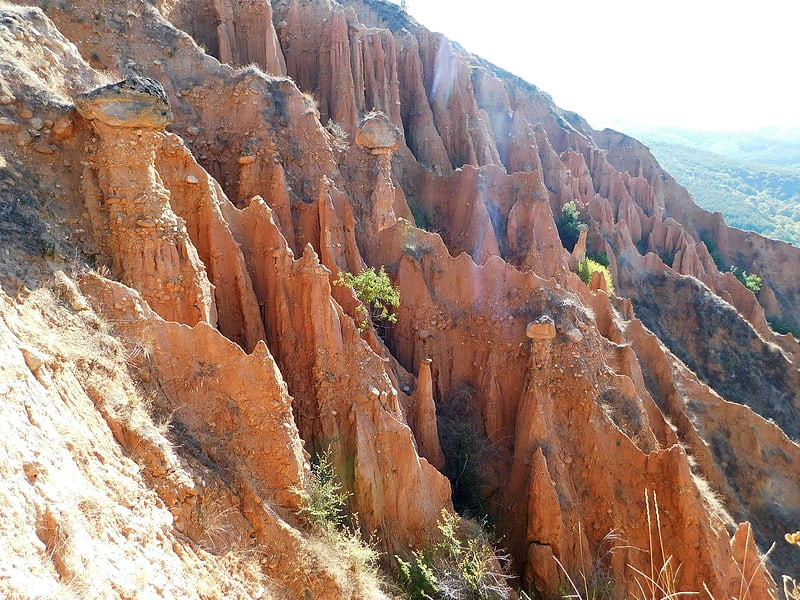
Nature preserve in Bulgaria. The Stob Earth Pyramids are rock formations, known as hoodoos, situated at the foothills of the Rila mountain range in south-western Bulgaria. They span an area of 0.7 km2 near the village of Stob, Kyustendil Province. The rock formations are up to 12 m high and up to 40 m thick at the base. Their shape is mostly conical to mushroomlike. Some of the columns are topped by flat stones.[41]
Botev Peak, Central Balkan National Park
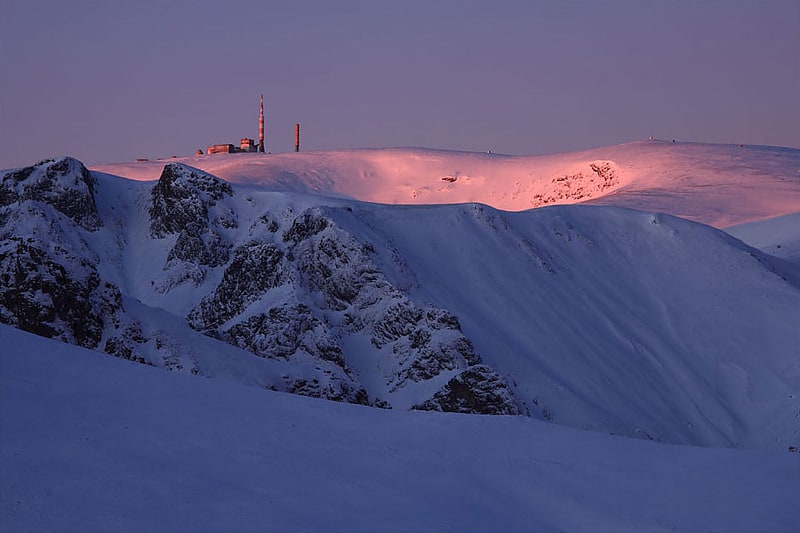
Also known as: Ботев
Prominent mountain with scenic views. Botev Peak is, at 2,376 metres above sea level, the highest peak of the Balkan Mountains. It is located close to the geographic centre of Bulgaria, and is part of the Central Balkan National Park.
Until 1950, when it was renamed in honour of Bulgarian poet and revolutionary Hristo Botev, the peak was called Yumrukchal (Юмрукчал, from Ottoman Turkish Yumrukçal, 'a fist-like peak').
A weather station and a radio tower (opened on 10 July 1966) that covers 65% of the country are located on Botev Peak. The average temperature is −8.9 °C (16.0 °F) in January and 7.9 °C (46.2 °F) in July.
"Botev Peak" is the main facility of Bulgarian FM and TV broadcasting network. The situation at the top near the geographical center of Bulgaria contribute to national radio broadcasts and television broadcast here to cover more than 65% throughout the country, also in parts of Romania and Turkey.
The massif is mainly composed of granite rocks dating from the oligocene — a complex of medium acid volcanics — latites, andesites, shoshoneites.
The flat ridge relief around Botev and Triglav is isolated with high slopes, which from the north (North Jendem) descend steeply from 2000 – 2200 m down, and from the south (South Jendem) — from 1800 – 1900 m.[42]
Konaka Museum, Vidin

Also known as: Музей „Конака“
Museum in Vidin, Bulgaria. The Historical Museum Vidin, sometimes shortened to Konaka museum, is located in Vidin, Bulgaria. The museum, founded in 1956, is situated in a former Ottoman konak. The nice building is among the cultural memorials of the region.
Originally the 18th-century building was used as the Home by Osman Pazvantoğlu and later as police office, and the central tower was a lighthouse. After liberation the building was reconstructed and enriched with elements from Bulgarian Renaissance architecture. In 1956, the building was used for a historical weapon show.[43]
Monument to 1300 Years of Bulgaria, Shumen
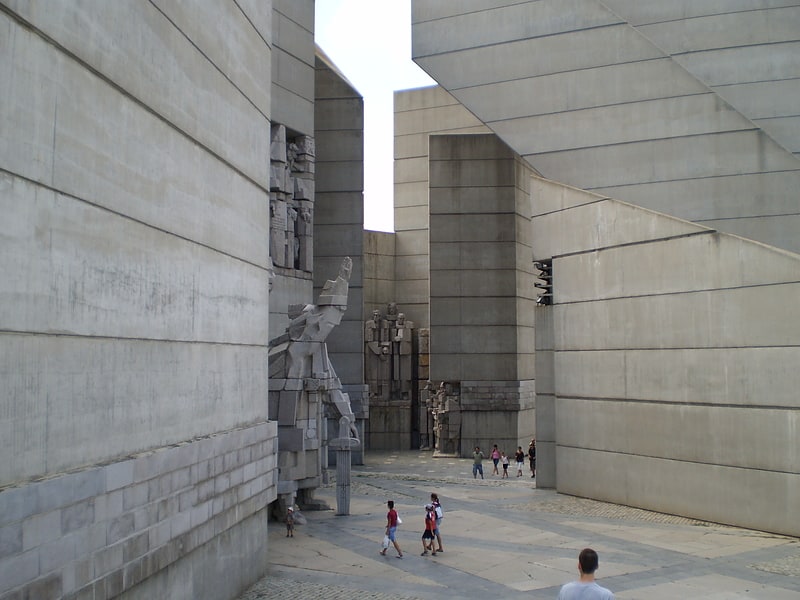
Also known as: Създатели на българската държава
Open air museum in Shumen, Bulgaria. The Monument to 1300 Years of Bulgaria, also known as the Founders of the Bulgarian State Monument, is a large monument built on a plateau above the city of Shumen, Bulgaria. It was built in 1981 to commemorate the 1300th anniversary of the First Bulgarian Empire.
The monument is built in concrete in a Cubist style, and designed by Bulgarian sculptors Krum Damyanov and Ivan Slavov. It is reached by a processional concrete stairway from Shumen, or by road. It stands at a height of 450 m above sea level and can be seen from 30 km away.[44]
Shumen fortress, Shumen
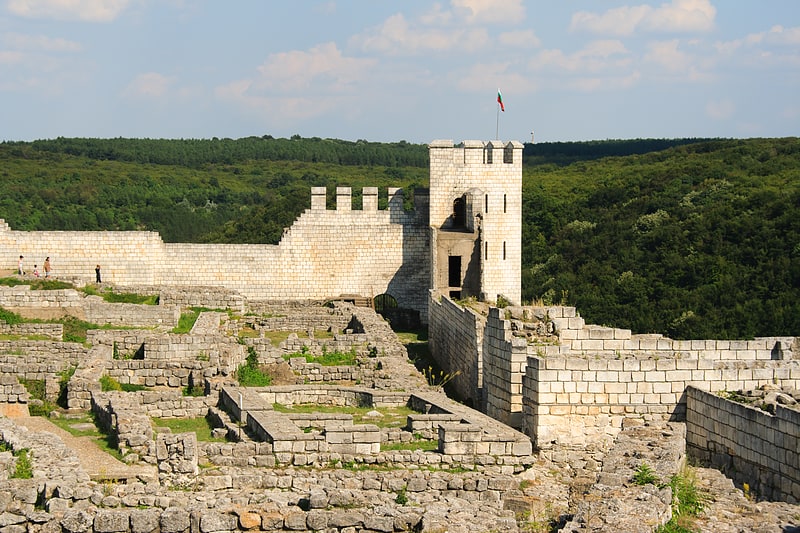
Also known as: Шуменска крепост
Fortress in Bulgaria. The Shumen fortress is an archaeological site overlooking the city of Shumen in north-eastern Bulgaria.
It is an ancient fortress with historical links to a village nearby traced to early Iron Age and later owned by the Thracians in the 5th century BC. Then, from 2nd to 4th centuries AD, it was controlled by the Romans who built towers and walls, and it was refurbished by the Byzantines as their garrison town. Shumen thrived in the Middle Ages as an important stronghold of the Bulgarian Empire. In 1444 the fort was destroyed by the Ottomans after their victory in the Battle of Varna over a Christian army under Władysław III of Poland. The fortress remained deserted ever since.
Restoration works on the fortress commenced in 2012 under the project titled “Bulgaria Begins Here”, and was completed partially in 2015 with financial assistance provided under the European Economic Area (EEA) and Norway Grants to the Shumen Municipality and the Shumen Regional Museum of History.[45]
Malak Rezen, Vitosha
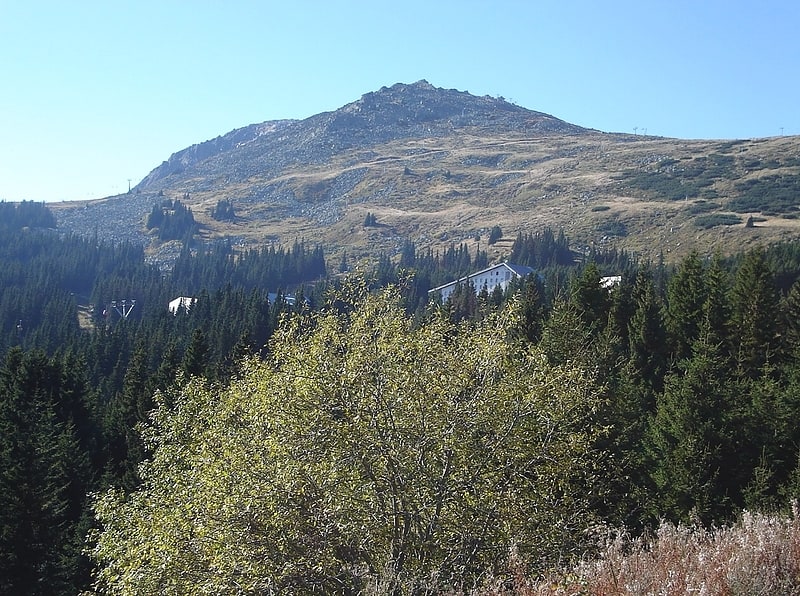
Also known as: Малък Резен
Peak in Bulgaria. Malak Rezen is a peak rising to 2,191 m in northeastern Vitosha Mountain in Bulgaria. The peak is situated 1.5 km northeast of the summit Cherni Vrah, and 1.3 km north by east of Golyam Rezen Peak, surmounting Stenata ski run and Aleko site to the north.
Malak Rezen is accessible by the Romanski chair lift, and serves in turn as a convenient starting point for the three highest peaks of Vitosha Mountain — Cherni Vrah, Golyam Rezen, and Skoparnik.
Rezen Knoll on Livingston Island in the South Shetland Islands, Antarctica is named for the peaks of Malak Rezen and Golyam Rezen.[46]